November 2024
The global landscaping and gardening service market size is calculated at USD 129.7 billion in 2025 and is forecasted to reach around USD 201.9 billion by 2034, accelerating at a CAGR of 5.04% from 2025 to 2034. The North America market size surpassed USD 44.45 billion in 2024 and is expanding at a CAGR of 5.19% during the forecast period. The market sizing and forecasts are revenue-based (USD Million/Billion), with 2024 as the base year.
The global landscaping and gardening service market size accounted for USD 123.48 billion in 2024 and is predicted to increase from USD 129.7 billion in 2025 to approximately USD 201.9 billion by 2034, expanding at a CAGR of 5.04% from 2025 to 2034. The landscaping and gardening services market is growing due to rising demand for sustainable solutions, technological advancements, corporate investments, and the increasing popularity of outdoor living spaces, driven by urbanization and real estate expansion.
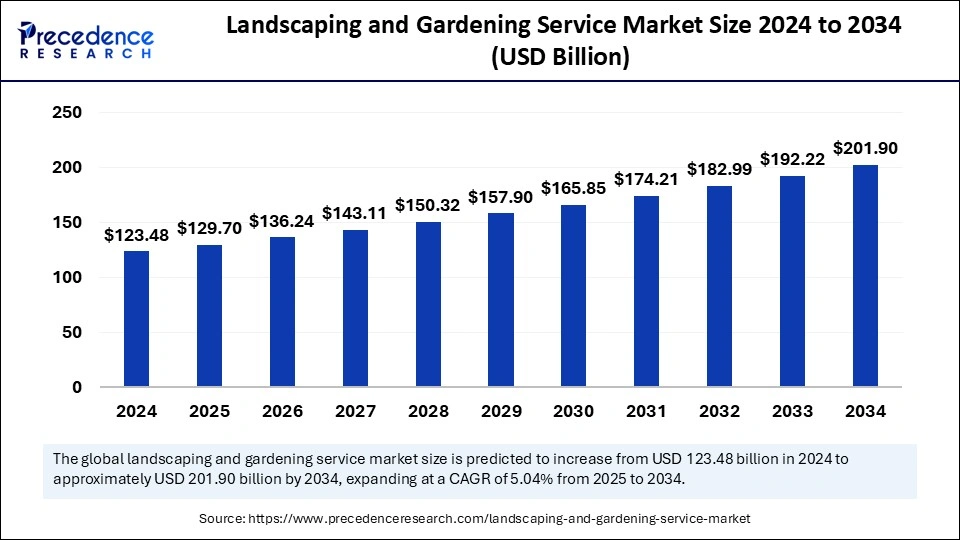
The landscaping and gardening service market is undergoing an intense transformation from an old technology, where people still depend heavily on their power. AI-powered tools like robotic lawnmowers, smart irrigation systems, and predictive maintenance models help lower labor and resource use costs. The use of the technologies supports eco-friendly practices as it cuts the water wastage and enhances the health of the plants while decreasing the dependency on chemical treatments.
The surge in sustainability needs among consumers is further accentuating this trend and has provided for the regulatory structure to squeeze into such measures that have driven artificial intelligence to be adopted in landscaping. Companies embracing AI technology in their work will gain a competitive edge, appealing to eco-friendly consumers, raising operational efficiency in an increasingly automated market.
The U.S. landscaping and gardening service market size was exhibited at USD 31.12 billion in 2024 and is projected to be worth around USD 51.95 billion by 2034, growing at a CAGR of 5.26% from 2025 to 2034.
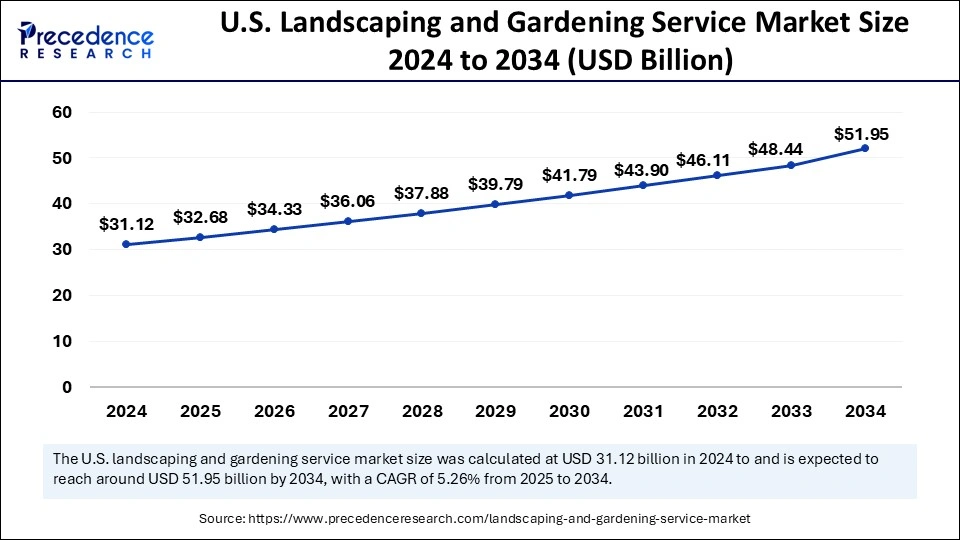
North America: Sustainable Practice and Technological Integration Dominating the Region.
North America led the global landscaping and gardening service market with the highest share in 2024, fueled by economic stability, premium consumer expenditure, and swift acceptance of technology. Environmental sustainability is now an essential consideration, with homeowners and companies increasingly looking to spend on environmentally friendly landscaping options. The United States government has further fueled industry expansion with initiatives such as the Department of Agriculture's US$1 billion grant scheme for the reforestation of cities, fighting climate change, and expanding access to green space.
In the United States, the landscaping business is changing at a fast pace with an emphasis on sustainability. Businesses are leading the way in green solutions, including Shades of Green Permaculture's EcoLawns service, which employs all-electric, solar-powered lawn equipment to minimize emissions and noise pollution. Quiet Green Lawns has also brought quieter, battery-powered leaf blowers, addressing increasing consumer demand for eco-friendly lawn maintenance. In spite of legislative reverses, such as Georgia's 2023 statute limiting municipal prohibitions on gas-powered landscaping equipment, industry stakeholders still urge more eco-friendly alternatives. With mounting ecological consciousness and governmental support, the U.S. landscaping market can expect sustained long-term expansion in sustainable services.
Canada's landscaping and gardening market is growing under robust government initiatives supporting urban greening, sustainability, and biodiversity. Urban area coverage by greenery increased to 70.3% in 2024 from 68.1% in 2023. Green roof regulations in Toronto, community gardening initiatives in Vancouver, and initiatives such as the Greening Government Strategy are influencing green landscaping for environmental conservation through reduced emissions, irrigation requirements, and pesticide use, along with improved urban ecology. With increasing consumer demand and regulatory encouragement, Canada is a leading figure in North America's landscaping industry.
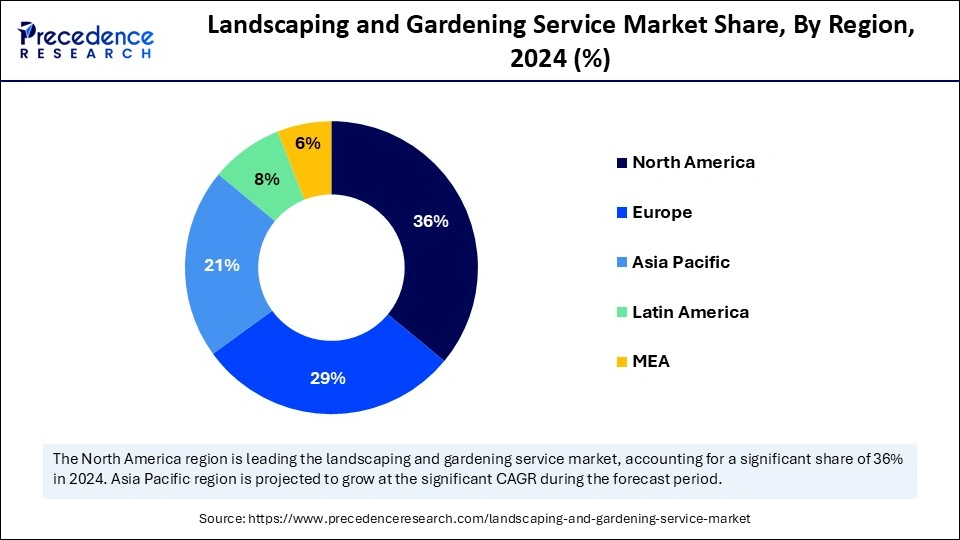
Asia Pacific: Urbanization and Innovative Landscaping
Asia Pacific is estimated to expand the fastest CAGR in the landscaping and gardening service market between 2025 and 2034 in the wake of accelerated urbanization and rising environmental awareness. Governments are adopting urban greening programs for better public health and environmental sustainability. The Sponge City initiatives in China include the use of green infrastructure to absorb stormwater and reduce flood hazards, thus reshaping the urban landscape into environments that can absorb water. At the same time, cities such as Shanghai are also bringing in larger green spaces with eco-friendly features, such as the Twin Hills project with artificial mountains covered with thousands of trees on top of a multilevel car park, merging the cityscape with the beauty of nature.
Japan's landscaping techniques blend beautifully in harmony with traditional styles and contemporary innovations. The government's "Digital Garden City Nation" initiative seeks to rejuvenate rural regions by combining digital technology with conventional landscaping, encouraging environmentally friendly urbanization. Architectural styles like Itsuko Hasegawa's Shonandai Cultural Center reflect this convergence by designing contemporary garden landscapes that retain traditional Japanese design sensibilities.
Furthermore, AI-designed gardens are becoming more evident, thus opening possibilities for innovative avenues in landscape sustainability and beauty. The strategy aims at maintaining the cultural heritage while concurrently catering to modern urban necessities, a testament to Japan's commitment to environmental stewardship and cultural conservation.
Europe's Landscaping and Gardening Services Market Set for Remarkable Growth
The European landscaping and gardening service market is poised for considerable growth over the next few years. The growth is propelled by the industry's aggressive adoption of climate change and economic volatility through sustainable approaches and innovative technology. The EU Strategy on Adaptation to Climate Change, adopted by the European Commission, calls on member states to develop comprehensive adaptation plans in order to make Europe a climate-resilient continent by 2050. The initiative focuses on adapting smarter, faster, and more systemically, with a strong push for incorporating green infrastructure and nature-based solutions in urban design.
In the United Kingdom, urban greening has been accelerated through strategic planning and policy measures. Natural England's release of the Green Infrastructure Framework seeks to raise green cover to 40% in urban residential zones, improving access to nature and providing significant health and environmental advantages. Besides, the UK government has encouraged local councils to assist schemes in which green spaces become easily accessible to the masses of urban people, in the spirit of the government making nature part of its whole plan for urban life. These schemes align with the requirements of the Environment Act 2021, which demands a net biodiversity gain of at least 10% on new developments and integrates sustainability into the landscaping sector.
The landscaping and gardening service market deals with the design, installation, and maintenance of exterior spaces to heighten their aesthetics, functionally, and environmental seriousness. It is residential, commercial, and public spaces, offering services such as lawn care, garden maintenance, hardscaping, and irrigation system installation. The growth of the market is on account of the rising customer interest in outdoor living areas and sustainable landscaping solutions.
Property owners are looking for eco-friendly practices such as drought-resistant planting, organic gardening, and smart irrigation systems to improve resource use and lessen environmental impact. Forward-thinking businesses and commercial establishments are investing in professional landscaping for property aesthetic enhancement and the establishment of greener environments.
Technology in the Landscaping and Gardening Service Market
Technological advancements are paving the way for a remaking of the landscaping and gardening service market, with AI-inspired landscape design, robotic lawn care, and automated irrigation systems driving their market share on efficiency and customization. The increasing demand for less maintenance and climate-adaptive landscaping solutions further ensures market prosperity, keeping innovation and sustainability a key driver for future growth.
| Report Coverage | Details |
| Market Size by 2034 | USD 201.9 Billion |
| Market Size in 2025 | USD 129.7 Billion |
| Market Size in 2024 | USD 123.48 Billion |
| Market Growth Rate from 2025 to 2034 | CAGR of 5.04% |
| Dominating Region | North America |
| Fastest Growing Region | Asia Pacific |
| Base Year | 2024 |
| Forecast Period | 2025 to 2034 |
| Segments Covered | Type, Application, and Regions. |
| Regions Covered | North America, Europe, Asia-Pacific, Latin America, and Middle East & Africa |
Urbanization and Real Estate Development: A Key Driver of Landscaping Growth
Urbanization and rapid real estate expansion are creating increased demand for the landscaping and gardening service market. As cities continue to grow, there is a need for well-planned green spaces- proper green spaces that are necessary for enhancing environmental quality, the aesthetic appeal of any area, and the well-being of people living in that area. Urban migration is also the cause of rising residential and commercial real estate developments, which in turn has raised the demand for landscape design, maintenance, and sustainable green infrastructure.
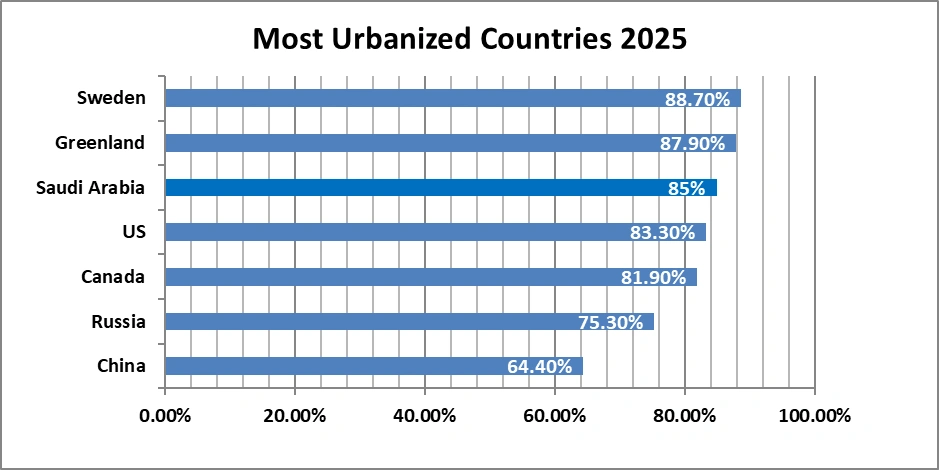
High Material & Transport Costs: A Major Challenge for Landscaping
Raw material price rises and the increasing challenge of changing transportation costs are two of the greatest hindrances in the global landscape and gardening market. Essential materials like fertilizers, seeds, mulch, and decorative stones have increased in price mainly due to the recent soaring inflation, bottlenecks on supply chains, and volatility within the global economy. Rising fertilizer fees come with geopolitical disputes, exacerbated by greater overall energy costs. In addition, alterations in fuel pricing have a direct effect on transport costs, increasing, of course, the price of getting tools and equipment where they need to be.
Rise of Sustainable Landscaping: A Growing Market Opportunity
The growing demand for sustainable and eco-friendly landscaping solutions is a key opportunity in the landscape and gardening market. Environmental awareness and climate change concerns have made homeowners, businesses, and municipalities buy drought-resistant plants, install rain gardens, and build permeable pavings to conserve water and reduce carbon footprints. An example is Los Angeles and Sydney, where residents are incentivized to substitute traditional lawns with native and water-efficient plants.
For instance, Marina One in Singapore features a 65,000 sq. ft. "Green Heart" that incorporates a multi-level of vegetation meant to increase biodiversity and air quality in a high-density urban setting. Moreover, companies such as Scotts Miracle-Gro and BrightView Holdings have started to provide organic fertilizers and sustainable landscaping designs to expand their services. Such a trend unravels a plethora of lucrative opportunities for businesses dealing in environmental-friendly gardening and landscaping solutions.
The maintenance segment held the largest landscaping and gardening service market share in 2024, covering major tasks such as mowing, trimming, fertilizer application, pest control, and irrigation maintenance. The rising demand for well-manicured lawns, especially in urban and suburban areas, has fueled growth in this segment. The sidewalks of residential homeowners, corporate office parks, and municipalities are left in this maintenance type. Moreover, the increasing inclination towards sustainable landscaping, such as organic lawn care and water-efficient irrigation, is a prime reason why this sector leads the market.
The construction segment is anticipated to grow at a remarkable CAGR between 2025 and 2034, specializing in the design of landscapes directed toward the functional and aesthetic characteristics of outdoor spaces. It includes hardscaping and installing features such as irrigation systems, lighting, and walkways. The demand for high-end landscaping has been on the rise for commercial properties, luxury residences, and urban planners pursuing sustainable developments alike. As cities and corporations around the globe continue investing in green infrastructure, rooftop gardens, and eco-friendly designs, it becomes the most dynamic sector in the industry, raising property and environmental values alike.
The residential segment captured the biggest landscaping and gardening service market share in 2024. Lawn care, seasonal planting, and custom garden design are a few examples of the services that have gained traction, especially post-pandemic, when outdoor living became a priority. Increased demand can also be traced back to trends such as edible gardens, smart irrigation, and drought-resistant landscaping. Besides, having a well-maintained landscape improves property values significantly, meaning professional landscaping has become an inherent aspect of home improvement across regions.
The commercial segment is expected to expand at a notable CAGR over the projected period as companies and public institutions appreciate the role of landscaping in beautification, sustainability, and regulatory compliance. Landscaping is becoming a popular investment among office complexes, hotels, resorts, and healthcare facilities to enhance curb appeal, attract clients, and improve workers' quality of life. Green spaces, walking trails, and eco-friendly infrastructure have now become a standard in corporate campuses and urban developments. Landscaping is growing bigger in commercial value and could even outweigh residential developments in many regions, for businesses are now more aware of sustainable practices.
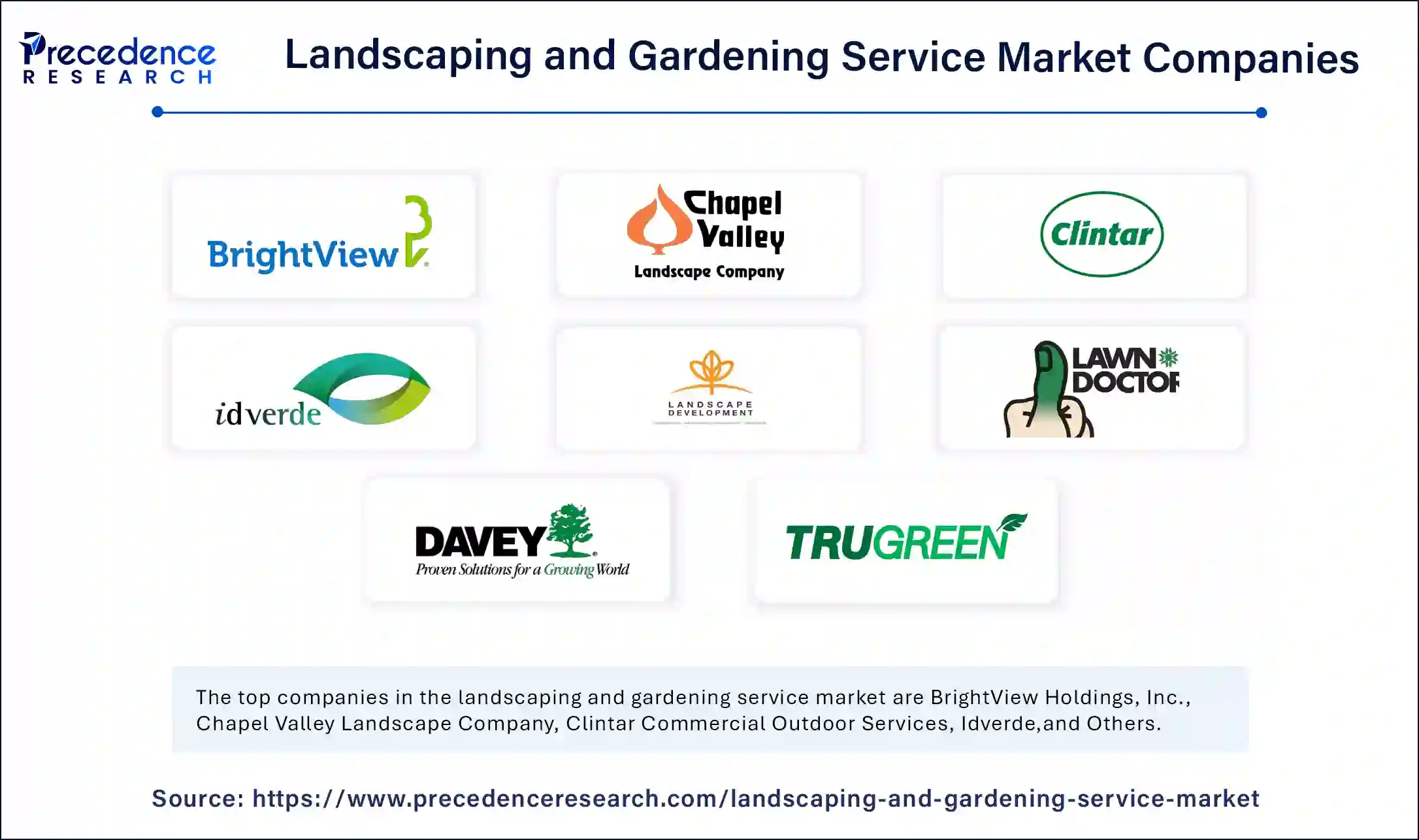
By Type
By Application
By Geography
For inquiries regarding discounts, bulk purchases, or customization requests, please contact us at sales@precedenceresearch.com
No cookie-cutter, only authentic analysis – take the 1st step to become a Precedence Research client
November 2024
February 2025